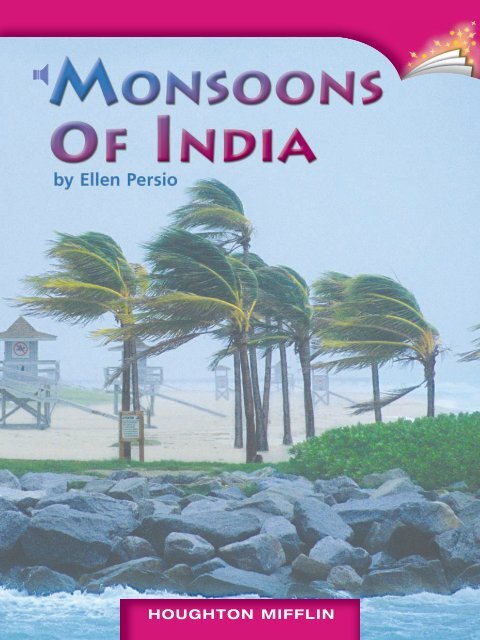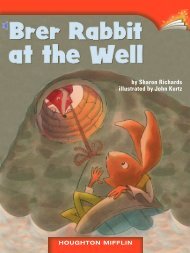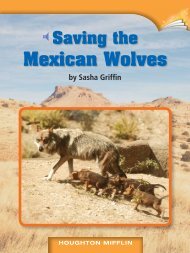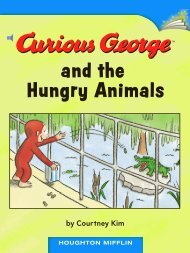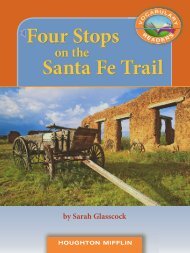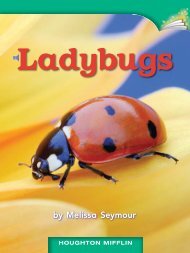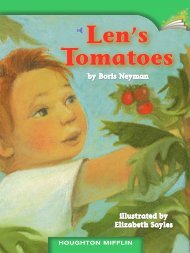Lesson 16:Monsoons of India
Lesson 16:Monsoons of India
Lesson 16:Monsoons of India
Create successful ePaper yourself
Turn your PDF publications into a flip-book with our unique Google optimized e-Paper software.
HOUGHTON MIFFLIN
y Ellen Persio<br />
ILLUSTRATION CREDITS: 8 Studio Montage; 10, 11 Joe LeMonnier / Melissa Turk<br />
PHOTOGRAPHY CREDITS: Cover © Warren Faidley / Corbis; 1 © Gideon Mendel / Corbis; 2 © Hemera Technologies; 5<br />
© Gideon Mendel / Corbis; 6 © Galen Rowell / Corbis; 7 (left) © PhotoDisc / US Landmarks & Travel, (right) © Warren<br />
Faidley / Corbis; 13 © Roger Wood / Corbis<br />
Copyright © by Houghton Mifflin Company. All rights reserved.<br />
No part <strong>of</strong> this work may be reproduced or transmitted in any form or by any means, electronic or mechanical,<br />
including photocopying or recording, or by any information storage or retrieval system without the prior written<br />
permission <strong>of</strong> Houghton Mifflin Company unless such copying is expressly permitted by federal copyright law.<br />
Address inquiries to School Permissions, Houghton Mifflin Company, 222 Berkeley Street, Boston, MA 021<strong>16</strong>.<br />
Printed in China<br />
ISBN-13: 978-0-547-02759-3<br />
ISBN-10: 0-547-02759-1<br />
1 2 3 4 5 6 7 8 9 NOR 15 14 13 12 11 10 09 08
Table <strong>of</strong> Contents<br />
Introduction . . . . . . . . . . . . . . . . . . . . . . . . . . . . . . . . . . . . . . . . . . . 3<br />
The Story <strong>of</strong> <strong>Monsoons</strong>. . . . . . . . . . . . . . . . . . . . . . . . . . . . . . . . . . 4<br />
How <strong>Monsoons</strong> Form. . . . . . . . . . . . . . . . . . . . . . . . . . . . . . . . . . . 6<br />
<strong>Monsoons</strong> and <strong>India</strong>’s Climate . . . . . . . . . . . . . . . . . . . . . . . . . . . 9<br />
Living with <strong>Monsoons</strong> . . . . . . . . . . . . . . . . . . . . . . . . . . . . . . . . . 12<br />
Good and Bad <strong>Monsoons</strong>. . . . . . . . . . . . . . . . . . . . . . . . . . . . . . . 14<br />
Conclusion . . . . . . . . . . . . . . . . . . . . . . . . . . . . . . . . . . . . . . . . . . . 17<br />
Glossary . . . . . . . . . . . . . . . . . . . . . . . . . . . . . . . . . . . . . . . . . . . . . 18
“The clouds advance like . . . armies;<br />
their flag is lightning,<br />
the thunder is their drum. . . .”<br />
— Kalidasa (Ancient <strong>India</strong>n Poet)<br />
Introduction<br />
A dusty wind blows through the streets. Shoppers look<br />
to the sky. High above majestic hills, clouds build. Soon, black<br />
clouds block the sun. Rain pours down. Thunder booms so<br />
loud it hurts people’s ears.<br />
Visitors run inside. But the people <strong>of</strong> the village stay<br />
outside. They open their arms to welcome the rain. Some<br />
cheer. The summer rains have returned!<br />
A week later, it is still raining. Only a few people go<br />
outside now. The rivers overflow and flood the streets. Rats<br />
and snakes swim in the brown water. The ruthless wind and<br />
rain makes buildings weak. Many houses have straw ro<strong>of</strong>s<br />
that leak.<br />
Welcome to Cherrapunji, <strong>India</strong> — one <strong>of</strong> the wettest<br />
places on Earth.<br />
3
The Story <strong>of</strong> <strong>Monsoons</strong><br />
In 1860, Cherrapunji set a record. That year, 1,000 inches<br />
<strong>of</strong> rain fell in the summer. That’s over 83 feet <strong>of</strong> rain! <strong>Monsoons</strong><br />
caused the rain. <strong>Monsoons</strong> are strong winds. These winds blow<br />
from one direction in certain months. In other months, the<br />
winds blow from the opposite direction.<br />
These winds cause big weather changes. Most summers,<br />
there are heavy rains. But in September, a long dry period<br />
usually starts.<br />
In <strong>India</strong>, monsoons are a matter <strong>of</strong> life and death. Some<br />
years, <strong>India</strong> gets too much summer rain. Floods can hurt crops<br />
and kill people. But too little winter rain can kill crops. Without<br />
monsoons, <strong>India</strong>’s farmland might be a desert.<br />
Average<br />
Rainfall<br />
Each Year<br />
Summer monsoons<br />
supply most <strong>of</strong><br />
<strong>India</strong>’s rainfall.<br />
435 inches<br />
460 inches<br />
50 inches<br />
Atlanta,<br />
Georgia<br />
Cherrapunji,<br />
<strong>India</strong><br />
Mount Waialeale,<br />
Hawaii<br />
4
A Common Experience<br />
People in <strong>India</strong> share a common experience. They have<br />
all experienced the monsoons. The monsoons helped forge, or<br />
create, <strong>India</strong>n culture.<br />
The story, or saga, <strong>of</strong> <strong>India</strong> and the monsoons started<br />
millions <strong>of</strong> years ago. The monsoons play two parts in this<br />
story. Sometimes, the monsoons are good friends. But other<br />
times, they are enemies. Today, <strong>India</strong>’s fate, or destiny, depends<br />
on the monsoon winds.<br />
<strong>Monsoons</strong> affect every part <strong>of</strong> life in <strong>India</strong>.<br />
Water buffalo<br />
5
The Tibetan Plateau is called<br />
the “Ro<strong>of</strong> <strong>of</strong> the World.”<br />
How <strong>Monsoons</strong> Form<br />
People have always wondered about monsoons. How do<br />
they work? Why do they have so much wind power? Scientists<br />
are working to answer these questions.<br />
One way scientists learn about monsoons is by studying<br />
the ocean. Sand and other things sink to the bottom <strong>of</strong> the<br />
ocean. Everything that sinks to the bottom creates sediment.<br />
Scientists study the sediment. They want to see what is in it.<br />
Then, they can see how <strong>India</strong>’s monsoons have changed.<br />
Scientists think a big change took place millions <strong>of</strong> years<br />
ago. Back then, <strong>India</strong> was an island. It drifted toward Asia. The<br />
two pieces <strong>of</strong> land crashed together. This crash formed two <strong>of</strong><br />
the highest places on Earth: the Himalaya Mountains and the<br />
Tibetan Plateau (pla TOH). Scientists think the Tibetan Plateau<br />
made the monsoon winds stronger.<br />
6
Land, Water, and Sun Create <strong>Monsoons</strong><br />
Why do monsoons blow in the first place? <strong>Monsoons</strong> start<br />
when temperatures on land and on water differ. The sun causes<br />
these temperature differences.<br />
You can feel the temperature differences between land and<br />
water. Think <strong>of</strong> the beach on a sunny day. The sand may be hot,<br />
but the ocean may be cold! Why? Land changes temperature<br />
faster than water does. Land soaks up the sun. It gets hot more<br />
quickly than water.<br />
But land cannot hold all <strong>of</strong> the sun’s heat. Land transfers<br />
heat to the air. The air above land gets warm. Then it rises.<br />
Ocean winds can be gentle.<br />
<strong>Monsoons</strong> are very<br />
powerful winds.<br />
7
Flow <strong>of</strong> Hot and Cold Air<br />
The ocean doesn’t heat up as quickly as land does. So, the<br />
air above the water stays cool. Cool air is heavier than warm<br />
air. As the warm air above the land rises, the cool air above the<br />
ocean flows in to take its place. People on the beach feel this<br />
cool air as a gentle sea breeze. After the sun goes down, the<br />
breeze goes the other way. The air over land now cools more<br />
quickly. As the warm air over the ocean rises up, the cool air<br />
from the land blows out to sea (see diagram below).<br />
Hot and cold air switch places during monsoon season,<br />
too. But monsoons aren’t nice sea breezes. They are strong<br />
winds. How Earth moves in space makes the monsoons<br />
stronger. Differences in <strong>India</strong>’s land also affect the monsoons.<br />
Scientists think the Tibetan Plateau affects the monsoons, too.<br />
Air Flow at Night<br />
Warm air rises, and cool air falls. Air moves in a cycle, or<br />
circle, between land and sea.<br />
8
<strong>Monsoons</strong> and <strong>India</strong>’s Climate<br />
<strong>Monsoons</strong> play a key role in <strong>India</strong>’s climate, or weather<br />
patterns. <strong>Monsoons</strong> blow over the ocean. They blow over land.<br />
<strong>Monsoons</strong> take place every year. <strong>India</strong>’s climate is embodied,<br />
or made visible, by monsoons.<br />
The Summer Monsoon<br />
<strong>India</strong> gets very hot in the summer. The hot air above the<br />
land rises. Cool winds from the <strong>India</strong>n Ocean blow toward<br />
<strong>India</strong>. The winds carry<br />
clouds from the southwest.<br />
When the wind bumps into Monsoon Festivals<br />
the mountains, it pushes<br />
People in <strong>India</strong> celebrate the<br />
the clouds high into the sky. monsoons. They have parades.<br />
They sing ancestral songs<br />
The upper sky is very cold.<br />
about relatives from long ago.<br />
The water in the clouds<br />
turn into big, fat raindrops.<br />
The heavy rain falls to<br />
the ground.<br />
9
Cherrapunji is near the Himalayas. These mountains help make<br />
big rainclouds.<br />
The Winter Monsoon<br />
In the fall, the winds change. The winds blow from the<br />
opposite direction — from the northeast. These winds are<br />
called the winter monsoon. The winter monsoon dumps rain<br />
on southern <strong>India</strong>. The rest <strong>of</strong> <strong>India</strong> stays dry.<br />
10
In the summer, winds flow from the north and south<br />
over <strong>India</strong>. The winds meet along the red line. The air is<br />
pushed up, and rain falls.<br />
The Summer<br />
Monsoon’s Path<br />
<strong>Monsoons</strong> and<br />
Wildlife<br />
<strong>India</strong>’s summer<br />
monsoon brings heavy rains <strong>India</strong>’s wildlife depends<br />
on the monsoons. Heavy<br />
to most <strong>of</strong> <strong>India</strong>. Cool, wet<br />
rains mean juicy grass for<br />
air comes from the <strong>India</strong>n<br />
elephants and other animals<br />
Ocean. When it hits <strong>India</strong>’s to eat.<br />
hot, southwestern coast, the<br />
air splits into two parts.<br />
The western part blows across the Arabian Sea. The<br />
eastern part blows over the Bay <strong>of</strong> Bengal and bumps into the<br />
Himalayas. These mountains force the winds to turn west.<br />
When the winds turn west, they bring rain to an area <strong>of</strong> rich<br />
farmland. This area is called <strong>India</strong>’s Breadbasket.<br />
11
Living with the <strong>Monsoons</strong><br />
<strong>India</strong>’s first great civilization was the Harappan (huh<br />
RAWP un) culture. It began in the Indus River Valley. The<br />
Indus is one <strong>of</strong> <strong>India</strong>’s great rivers. The others are the Ganges<br />
(GAN jeez) and the Brahmaputra (brah mah POO truh).<br />
Many smaller rivers flow from the Himalayas. They carry<br />
rich soil to the plains. The rivers and monsoon rains attracted<br />
people from other areas. The soil was good for farming.<br />
Harappan farmers grew wheat, rice, and barley.<br />
When the monsoon rains increased, Harappan life<br />
improved. Scientists have dug up, or unearthed, children’s<br />
toys. They also found beautiful carved figures. All were made<br />
with great artistry. Scientists think that people even had time<br />
for fun, or recreational activities.<br />
The Harappans took great care <strong>of</strong> their water supply. They<br />
built irrigation systems. This helped farmers bring river water<br />
to their fields. They also built tanks to store water. Many cities<br />
had public baths. One city had indoor plumbing! They also<br />
used the rivers for travel and trade.<br />
12
Ruins from<br />
long ago<br />
Why were these buildings destroyed? Some experts<br />
think monsoons were the reason.<br />
A Civilization Ends<br />
The Harappan civilization lasted more than 800 years.<br />
Then, it disappeared. Why? Experts aren’t sure. They have two<br />
different ideas. Both ideas have to do with monsoons.<br />
The first idea says that monsoon rains increased. Floods<br />
destroyed farms and cities. So, people moved to other areas.<br />
The second idea blames monsoons, too. But the reason is<br />
not enough rain. The monsoons may have caused a drought, or<br />
long period <strong>of</strong> no rain. If so, people also had to move.<br />
13
Good and Bad <strong>Monsoons</strong><br />
<strong>Monsoons</strong> have affected people in <strong>India</strong> for a long time.<br />
They think about the monsoons a lot. They have strong feelings<br />
about them, too. People see the mighty monsoons as a sign <strong>of</strong><br />
hope. But they also know monsoons can cause trouble.<br />
The summer monsoon can bring good times or hard times.<br />
<strong>India</strong>’s farmers depend on monsoon rains. But these rains may<br />
come too late or fall too lightly. Crops may not grow.<br />
Sometimes, the rains fall too hard and wash away young<br />
plants. If wet weather lasts too long, crops go bad. Farmers are<br />
hurt the most. But the whole country suffers, too.<br />
Most workers in <strong>India</strong> are farmers. After a bad monsoon<br />
season, many people become poor. Poor people buy less.<br />
This means stores sell less. Factories shut down, and people<br />
lose their jobs.<br />
<strong>India</strong>’s leaders are trying to solve these problems. They<br />
work to protect the water supply. They look for better ways to<br />
predict, or forecast, the monsoons.<br />
14
<strong>Monsoons</strong> in Poetry<br />
The wet monsoon season can bring sadness. This feeling is<br />
embodied in a poem.<br />
The Twelve Seasons <strong>of</strong> the Farmer<br />
The sky has been torn open . . .<br />
The river became flooded,<br />
The crop is destroyed,<br />
The cattle died from hunger . . .<br />
And how is your peace my husband?<br />
I do not have any happiness.<br />
A Monsoon Joke<br />
Can weather forecasters predict monsoons? This <strong>India</strong>n joke<br />
suggests that they cannot!<br />
Army Officer: Hello. Weather Office? The General arrives<br />
tomorrow. We want to have an outdoor party for him. But<br />
we need good weather! Is there any chance <strong>of</strong> rain?<br />
Meteorologist: Hmm . . . let me look at my computer. I have<br />
some charts here, too. Good news! It looks like you will<br />
have a nice sunny day!<br />
Officer: Oh, thank you very much! Listen, why don’t you<br />
come to the party?<br />
Meteorologist: I’d love to . . . if it doesn’t rain.<br />
15
Managing <strong>Monsoons</strong><br />
Scientists use data from satellites and computers to<br />
forecast monsoons. The computers cost a lot <strong>of</strong> money. Plus, the<br />
results aren’t perfect. <strong>Monsoons</strong> are complex weather systems.<br />
Even a tiny change can affect the whole system.<br />
Some monsoons bring a lot <strong>of</strong> rain. Others bring very<br />
little. Either one can be deadly. Keeping a stable water supply<br />
takes a lot <strong>of</strong> work. Huge dams help prevent floods. Ditches<br />
and pipes bring water to dry areas. People collect rainwater<br />
on ro<strong>of</strong>tops and in wells. Still, floods and droughts remain a<br />
problem for <strong>India</strong>.<br />
The Problem <strong>of</strong> Deforestation<br />
For many years, farmers have burned <strong>India</strong>’s forests to<br />
make more farmland. This deforestation hurts the soil. Tree<br />
roots bring water into the soil. Roots and leaves also protect the<br />
soil from wind and rain. Without forests, the soil becomes dry<br />
and thin. Heavy monsoons wash and blow away this poor soil.<br />
<strong>16</strong>
Conclusion<br />
Big trucks create clouds <strong>of</strong> dust as they roll into the village.<br />
People wait as the truckers unload their goods. Huge barrels <strong>of</strong><br />
water land with a thump. Boxes <strong>of</strong> fruits and vegetables follow.<br />
People with money push ahead. The rest just watch. Later, they<br />
will walk miles to small streams, hoping to collect some water.<br />
This scene looks very different than the one we saw on<br />
Page 3. But it takes place in the same spot — Cherrapunji<br />
— a few months after the rains ended. Deforestation makes<br />
this winter dry spell worse. The ground is rocky and dry in<br />
many places.<br />
Less rain falls in the summer now. People worry that the<br />
summer rains might be less and less. Scientists think it’s too<br />
early to tell. Cherrapunji no longer gets as much rain as it did<br />
before. But its summers are still very wet.<br />
Scientists keep studying the monsoons. Are the monsoons<br />
changing? Could Cherrapunji turn into a desert? Or will it stay<br />
a wet place? For now, no one knows the answers.<br />
17
Glossary<br />
deforestation (dee for ust AY shun) n. the cutting down <strong>of</strong> large<br />
areas <strong>of</strong> trees<br />
drought (drowt) n. a long period <strong>of</strong> dry weather with no rain<br />
irrigation (eer uh GAY shun) n. a system for moving water from<br />
place to place<br />
sediment (SED uh mint) n. bits <strong>of</strong> soil, rock, or plants that settle<br />
to the bottom <strong>of</strong> water<br />
18
Responding<br />
TARGET SKILL Compare and Contrast<br />
How are the summer and winter monsoons<br />
different? How are they the same? Copy and<br />
complete the diagram below.<br />
Summer<br />
<strong>Monsoons</strong><br />
Both<br />
Winter<br />
<strong>Monsoons</strong><br />
? unpredictable ?<br />
?<br />
Write About It<br />
Text to World Suppose that you are a writer<br />
for a travel magazine. Make a list <strong>of</strong> travel<br />
tips for tourists visiting <strong>India</strong> in the summer<br />
monsoon season.<br />
19
TARGET VOCABULARY<br />
ancestral<br />
artistry<br />
destiny<br />
embodied<br />
forge<br />
majestic<br />
recreational<br />
ruthless<br />
sagas<br />
unearthed<br />
TARGET SKILL Compare and Contrast<br />
Examine how two or more details or ideas are alike<br />
and different.<br />
TARGET STRATEGY Summarize Briefly tell the<br />
important parts <strong>of</strong> the text in your own words.<br />
GENRE Informational Text gives facts and examples<br />
about a topic.<br />
Write About It<br />
In a famous quotation, Aung San Suu Kyi said,<br />
“Please use your freedom to promote ours.”<br />
What freedoms do you value most? Why? Write<br />
a letter to the editor <strong>of</strong> a Burmese newspaper<br />
explaining the freedoms you have and why they<br />
are important to you.<br />
20
Level: W<br />
DRA: 60<br />
Genre:<br />
Informational Text<br />
Strategy:<br />
Summarize<br />
Skill:<br />
Compare and Contrast<br />
Word Count: 2,070<br />
6.4.<strong>16</strong><br />
HOUGHTON MIFFLIN<br />
Online Leveled Books<br />
1032810


